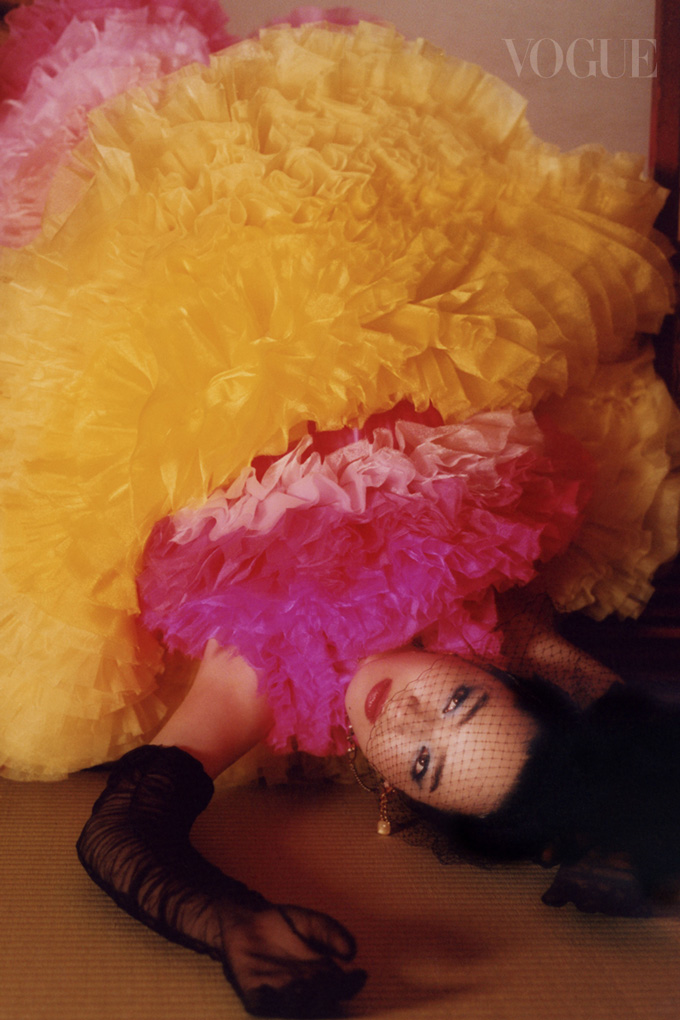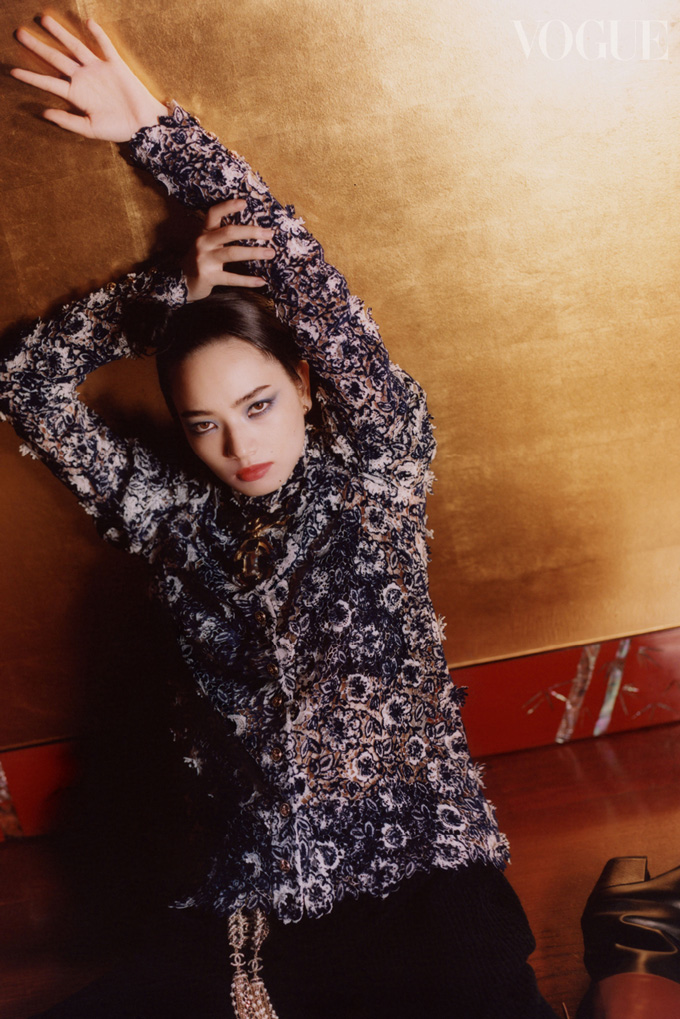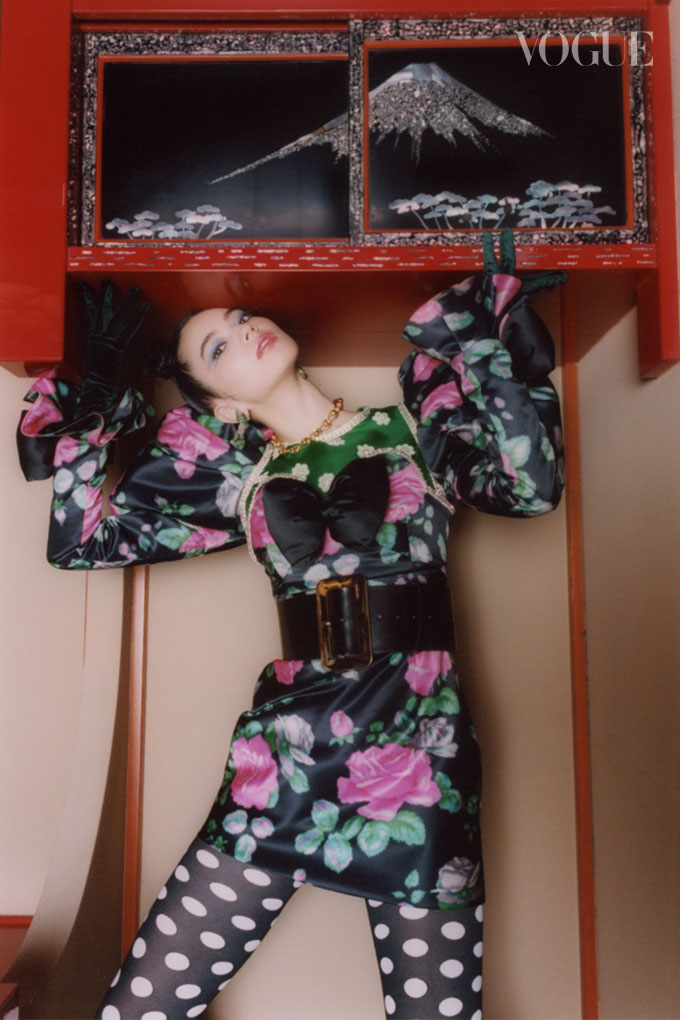Nana Komatsu arrives at photo shoots on her own, without a manager or an entourage of handlers to go through the rituals of introductions in a country that adheres to formalities. She is part of a new generation of Japanese actresses blessed with the presence and versatility to carry herself from movie sets to magazine covers, and sit in the front row at Chanel shows.
At 24 years of age, she has already appeared in over 20 films and dramas, including her latest starring role in the movie Threads—Our Tapestry of Love filmed in Singapore last year. This coming-of-age love story follows the lives of teens who grew up during a bleak time in Japan’s history, the Heisei era (1989-2019), when the country’s economic bubble burst, leading to the collapse of financial institutions, and followed by natural disasters that deeply affected the nation’s psyche.
Komatsu is also a child of the Heisei era and the film is an interesting observation of how her generation sees the world.
In the film, Komatsu’s character leaves Japan behind for a future in Singapore. “It was my first time in Singapore and we only had a week to film, so everything was incredibly intense,” she tells me in Tokyo. “My character Aoi had a dark past in Japan, but she had big dreams to see the world and Singapore was where she soared.” The story takes several dark turns thereafter, but the cinematography takes in the vibrant energy of modern-day Singapore, complete with a sweeping view of the infinity pool at Marina Bay Sands and the lively markets at night. There are scenes of Aoi working through various jobs in different locations throughout the city, from a manicurist to a housekeeper—shot at the beautiful Shangri-La Hotel—and eventually becoming president of her own company.

“The city looked so futuristic and everything was so clean. I actually got lost in a giant department store that had four basement floors. It was so huge!” she tells me excitedly as her eyes widen. “And Hainanese chicken rice was nothing like I’d had in Japan. It was so good, we tried new places, sometimes two in a day. We had so much fun.”
In contrast, life is not so kind to Komatsu’s character Aoi. And Aoi, in the movie, is at her lowest point when she is eating—not Hainanese chicken rice, but a Japanese dish called Katsudon, which is a fried pork cutlet with egg over rice. The scene was shot inside an actual Japanese restaurant, away from the city centre. And while she ate this familiar food in a foreign land, a popular Japanese song called ‘Ito’, which means ‘threads’ in Japanese (and hence the namesake of the movie) plays in the background, amplifying her sombre state.
The song by singer-and-songwriter Miyuki Nakajima, first released in 1998, has enjoyed multiple revivals in recent years mainly due to the beautiful melody and lyrics that explain how everyone you meet in life is connected like threads woven together to make a tapestry. Nakajima’s maternal voice is saying that everything in life has meaning and all will work out in the end. It’s an anthem for a generation that grew up with harsh realities and more than their fair share of disappointments.

This scene in the movie is tricky because Komatsu is eating and crying at the same time. And with Nakajima’s song playing in the background, it could easily have been overdramatised. But Komatsu does something remarkable and makes you believe in Aoi’s resilience. It’s one of the most moving moments in the film and lauded by many as the most memorable.
“We shot that scene on our very last day in Singapore. By then, I’d gone through so many emotions, the highs and the lows, that I knew exactly how Aoi felt. I didn’t have to rehearse it. We shot the scene in one take and afterwards the entire crew, Japanese and Singaporean, all got together for a group photo. I’m still amazed I got to work with such a great team.”
While the scene was a low point in Aoi’s life, the experience was the highlight of Komatsu’s time in Singapore. I ask her what was most challenging about doing this movie, being in a foreign country with so little time. Her answer catches me off guard, but it’s telling of how she views her responsibility as an actress. “When I first read the script, there were so many crying scenes,” she explains. “And I was worried because it’s important that Aoi doesn’t come across as a weak woman. I mean, she went through a lot, but here’s a woman who is opening her own doors and moving forward. I wanted her to be someone who is strong and living her own life.”
“If I get there and something doesn’t work, I need to do something about it and it’s up to me to make it work”
Komatsu was so concerned that she spoke to the director and producers to make Aoi more believable. “There’s only two hours in a movie and we had to cover 30 years of her life. I didn’t want the audience to leave with the impression that she was always so sad.”
Being of the same generation as Aoi, did she feel a special connection? “You know, I’m similar in that I always feel like no matter what happens, things will work out in the end. If I get there and something doesn’t work, I need to do something about it and it’s up to me to make it work.” This sentiment also reflects her preference to arrive on photo shoots alone. “I need to connect directly with the people I work with or else the work gets harder when I have to communicate through layers of people. I learnt this early on when I was a model.”

Born in 1996 outside Tokyo, Komatsu was just 12 years old when she was discovered by a modelling scout while shopping with her mother on Takeshita Street in Harajuku. She began modelling for teen magazines, but family, school and friends remained high on her list of priorities. She decided that moving to central Tokyo was not an option and that she would continue living with her parents and two older brothers.
“It was important for me to have my school life and friends because I always felt the friends you make at school are friends for life. And I just wanted to be with my friends all the time and talk and do fun things, like take purikura pictures [the Japanese photo booths that print out cards and stickers often traded among friends].”
A turning point occurred when Komatsu was 17. The acclaimed actor Kōji Yakusho, known abroad for such international hits as Tampopo and Shall We Dance?, was starring in a big suspense film and the director was looking for a young actress to play Yakusho’s daughter Kanako.
Komatsu says she had no aspirations of becoming an actress, but her modelling agent suggested she audition for the experience. Much to her surprise, Komatsu was cast as Kanako, the mysterious high school girl who suddenly disappears at the beginning of the movie, sending the estranged father (played by Yakusho) on a frantic and hyper-violent search to find her. Komatsu appears sporadically throughout the film mainly in flashbacks, but her charismatic presence is what makes the story chilling and dark.

The 2014 movie, called Kawaki (‘thirst’ in Japanese) was marketed overseas with the English title, The World of Kanako, which put Komatsu right at the centre of the main poster that made the rounds at various international film festivals, including Toronto and Busan. Meanwhile, in Japan, she quickly became the breakout star and won the prestigious Japan Academy Film Prize for Newcomer of the Year in 2015.
Still, Komatsu was not convinced she would continue acting. The movie was her first experience and she felt she was in over her head. “I didn’t know left from right or why I had to cry in one scene and laugh in another. I didn’t know anything about creating a role, so I cried out of frustration.”
She was still in high school which gave her the excuse she needed to decline acting offers that were coming her way. But as graduation neared, she thought long and hard about her life choices, including a long-time dream of becoming a hairstylist. In the end, her mother, who has always been supportive of her daughter’s decisions, said it was up to her but suggested she give acting a try. Komatsu has been working non-stop since. And is currently one of the most sought-after young actresses in Japan.
“I didn’t know anything about creating a role, so I cried out of frustration”
“I think my mother watches more movies now that I’m an actress. She loves to suggest new titles for me to see. And I do the same for her. As an adult, it’s a new way of communicating with parents and I feel like I’m being a good daughter,” she smiles.
Komatsu has acted in a wide range of roles, from manga-inspired tender love stories like After the Rain and Drowning Love in which she’s a Tokyo teen model who moves with her family to a rural town and falls in love with a local boy, played by the popular actor Masaki Suda, who is also her co-star in Threads—Our Tapestry of Love.
Their on-screen chemistry was also tested in a much darker film called Destruction Babies in which Suda and Komatsu’s characters traumatise each other. Not recommended for the faint of heart, the violent scenes were so intense that Komatsu still refers to Suda as a doshi or a ‘comrade in battle’.

One movie that stands out as a life-changing experience for Komatsu was appearing in Martin Scorsese’s epic historical drama, Silence, about the lives of Portuguese Jesuit priests in 17th-century Japan. Komatsu, who played a Christian woman (during a time when Christians were oppressed in Japan) tells me the experience made a huge impact on her as an actress. “Watching the foreign cast and how they expressed themselves and interacted with the director was so different from what I’d seen on Japanese movie sets. Actors voiced their opinions more and there was so much more discussion about the dialogue. Everything was so new and stimulating.”
At the same time, the experience of having to rely on an interpreter on set led her on a mission to improve her English language skills—something she has been continuing to do even to this day. “But I’m already 24,” she sighs. “My initial plan was to be fluent by the time I’m 24… I need to keep at it.”
While Komatsu says she would love to appear in other foreign films if the opportunity arises, another major role has been taking her to faraway lands as well. “I never dreamt I would be going abroad for work,” she says. This time, she’s referring to her role as house ambassador for Chanel. Before COVID-19 and all the restrictions placed on international travel, Komatsu could be seen sitting front row at the shows or attending many of the events and after-parties around the world.
“What I love the most about the work I do is the process of communicating and collaborating with the people I work with to create something”
She says she is still in awe of everything that has happened in her life and hopes she can continue to express herself through movies and fashion. But when the conversation turns to social media, Komatsu is less enthusiastic.
“I like to keep a good distance with social media,” she says with a pause. Komatsu doesn’t have any official social media accounts. “I love taking photographs on film so I take photos of landscapes or flowers, or something I see while I’m travelling. But if I take a really good picture, I probably won’t show it to anyone. I like to keep those for myself.”
Komatsu is a paradox of sorts. She likes to connect with people but is private in person and likes to do things on her own. She is also into running, another solitary sport, and tells me she has been jogging at least an hour a day to stay fit during self-quarantine.

“People assume I love being the centre of attention because I model, but it’s not true at all. What I love the most about the work I do is the process of communicating and collaborating with the people I work with to create something. It’s that connected feeling and a kind of trust that accumulates over time that I cherish the most.”
I ask her what advice she would give her teenage self and she responds without missing a beat: “No experience is wasted. Don’t be afraid to go out and experience as much as you can, and make as many mistakes, because you can afford to make mistakes when you’re young. People are generally kind. And things will work out in the end.”
There’s a poignant scene in the movie, Threads—Our Tapestry of Love, where a mother tells her little girl to be kind to others and to hug anyone who is feeling sad. I bring this scene up when we are talking about what a post-pandemic world would look like and Komatsu’s eyes light up. “I hope we can all get through this and move forward to a kinder world where people can physically express their love for one another,” she says. “We work in an industry that’s all about close contact and crowds, which are the very things we’re being told to avoid. It made me realise more than ever how important human connection is.”

So, what does the future hold for her? Where does she see herself in, say, 10 years? She thinks for a while and gives me a long-winded answer in one run-on sentence, speaking slowly as if to collect her thoughts while she speaks. “I may be doing what I’m doing now, or I may meet someone and my interests may change, or I may quit being an actress, or I may be doing something more as an actress, or I may not be living in Japan. I’m having fun right now fantasising about all this,” she says with a smile.
The future is unknown. But one thing she knows for sure. “I’m definitely travelling back to Singapore the first chance I get!” She is particularly looking forward to visiting Gardens by the Bay and seeing the Supertrees, a destination her co-stars enjoyed while Komatsu had to stay on set to film. “I really wanted to go with everyone. Now I have to see it for myself.”
Photo credits
Photography: Fish Zhang
Stylist: Xander Ang
Hair: Takeshi Katoh at SEPT Inc.
Make-Up: Kie Kiyohara at Beauty Direction
Producer: Hiroki Sekiguchi at ID Management
Production assistant: Mayumi Yamanaka at Yamanaka Management
Video credits
Director & DP: Hiroki Sugiyama
Photographer: Fish Zhang
Fashion Stylist: Xander Ang
Hair: Takeshi Katoh at SEPT Inc.
Make-Up: Kie Kiyohara at Beauty Direction
Model: Nana Komatsu at Stardust
Producer: Hiroki Sekiguchi at ID Management
Production assistant: Mayumi Yamanaka at Yamanaka Management
Film production assistant: Torai Takaya
Photographer assistants: Hiroshi Asakura, Shun Fukasawa
Stylist assistants: Masatoshi Ota, Maiko Shibukawa
Special thanks to Junko Omi and Hotel Gajoen Tokyo
Location: Hotel Gajoen Tokyo
For more stories like this, subscribe to Vogue Singapore.





